You know what’s great about being a middle-class dude blogging about golf course architecture? I rarely play the World Top 100 clubs that are so over-discussed on social media that it’s positively impossible for me to find a new angle on them. Everything I say about Rhode Island Country Club is going to be new to somebody!
Anyway, that’s how I justify to myself why you would have interest in reading my own “Best of 2021” list, despite its lack of World Top 100s. To be honest, any “best courses I played” blog post is inherently cliché. And so I created a fun activity (for myself, if not any of my readers):
The six best courses I played during 2021 each came from a different architect’s pen. I considered what another architect on the list might do if they had the opportunity to renovate my least-favorite hole at a different course on the list that they didn’t create.
For example, what would happen if Pete Dye renovated No. 9 at Davenport Country Club? Let’s find out!
What would happen if PETE DYE renovated NO. 9 at DAVENPORT COUNTRY CLUB?
Davenport sits on a phenomenal piece of parkland. The great glaciers in the Iowa hills must have melted more violently than most as they poured down into the Mississippi, creating the many bumps and valleys that C.H. Alison would later design this underrated icon upon. I can’t recommend most of this course enough. One hole I could quite possibly recommend enough is No. 9.
The concept here is good, as is the setting. Players have two options from the tee: Play safe to the left side of the fairway, or ride up along the creek that follows the right fairway for the hole’s entire length. The latter gives you a straight shot into the reachable green (523 yards from the back tees) if you flirt with the creek again. Accessing this green is much more difficult from the left, as any graceless shot back toward the right side ends up wet. A good comparison point is Coore and Crenshaw’s second at Talking Stick (O’odham): Eventually you’ll need to wrangle with the hazard, but the sooner you do it, the greater your chance at scoring. Hitting the hazard, however, awards a point to opponents who took their time getting there.
The issue is the narrow corridor created by trees on both sides. Amateurs can’t play natural fades due to dense trees on the left, or a cut due to a similar story on the right. The trees on the left are a rare blotch on a course that otherwise features wide corridors, following restorative work from Ron Forse and Jim Nagle.
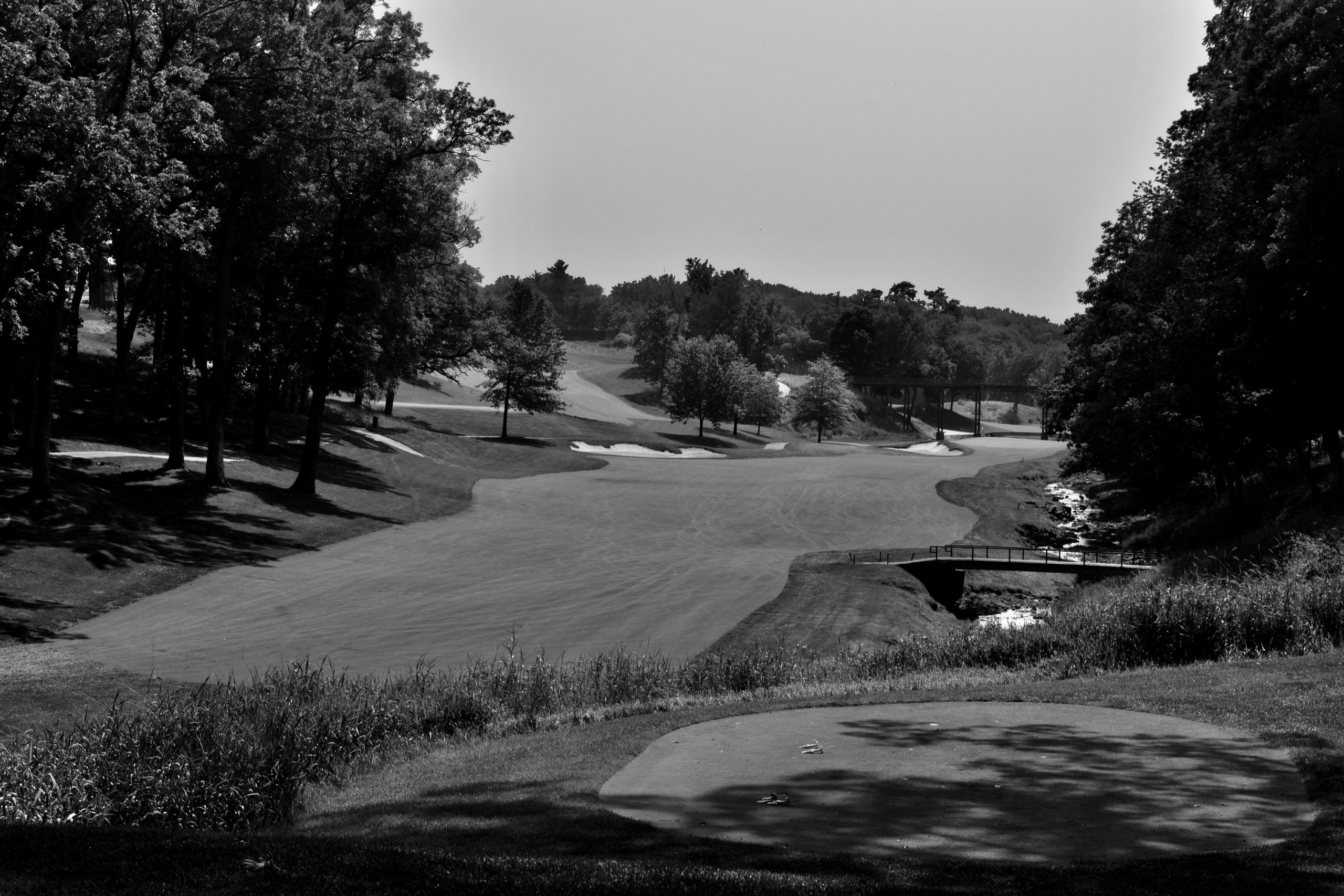 A cool thing from this hole we absolutely won’t mess with: The No. 10 bridge across the valley in the background. (Photo Cred: BPBM)
A cool thing from this hole we absolutely won’t mess with: The No. 10 bridge across the valley in the background. (Photo Cred: BPBM)
The aforementioned C&C hole owes something to lessons from Pete Dye, Coore’s mentor. And so I’ll use one of the best Dye holes I’ve ever played as an inspiration here: No. 13 from the Kiawah Ocean Course offers a similar idea, albeit as a par four.
Obviously, we’ll clear some of the offending trees from the left (removing those on the right would likely create erosion issues on the sharp hillside). This leaves quite a landing area for higher handicappers (myself included), but we also don’t want the safe route to make scoring opportunities easier from that side. Therefore we’ll add a cluster of bunkers cutting into the fairway, about 275 yards from the back tees. This forces the left-route golfer to be honest: If you want a two-shot-approach distance, you’ll need to get around (or over) these. Otherwise, lay up short and face a 250-yard approach at a bad angle.
One more Dye tweak: Would love to move the teeboxes a bit more west, for a tee shot that at least feels a bit more Cape-ish (not sure if this is possible while keeping players safe from very poor tee shots at No. 8).
Our…er, Dye’s changes keep the hole’s sliding-scale approach to risk-reward intact. But now it also gives bad golfers (again, me) room to breathe.
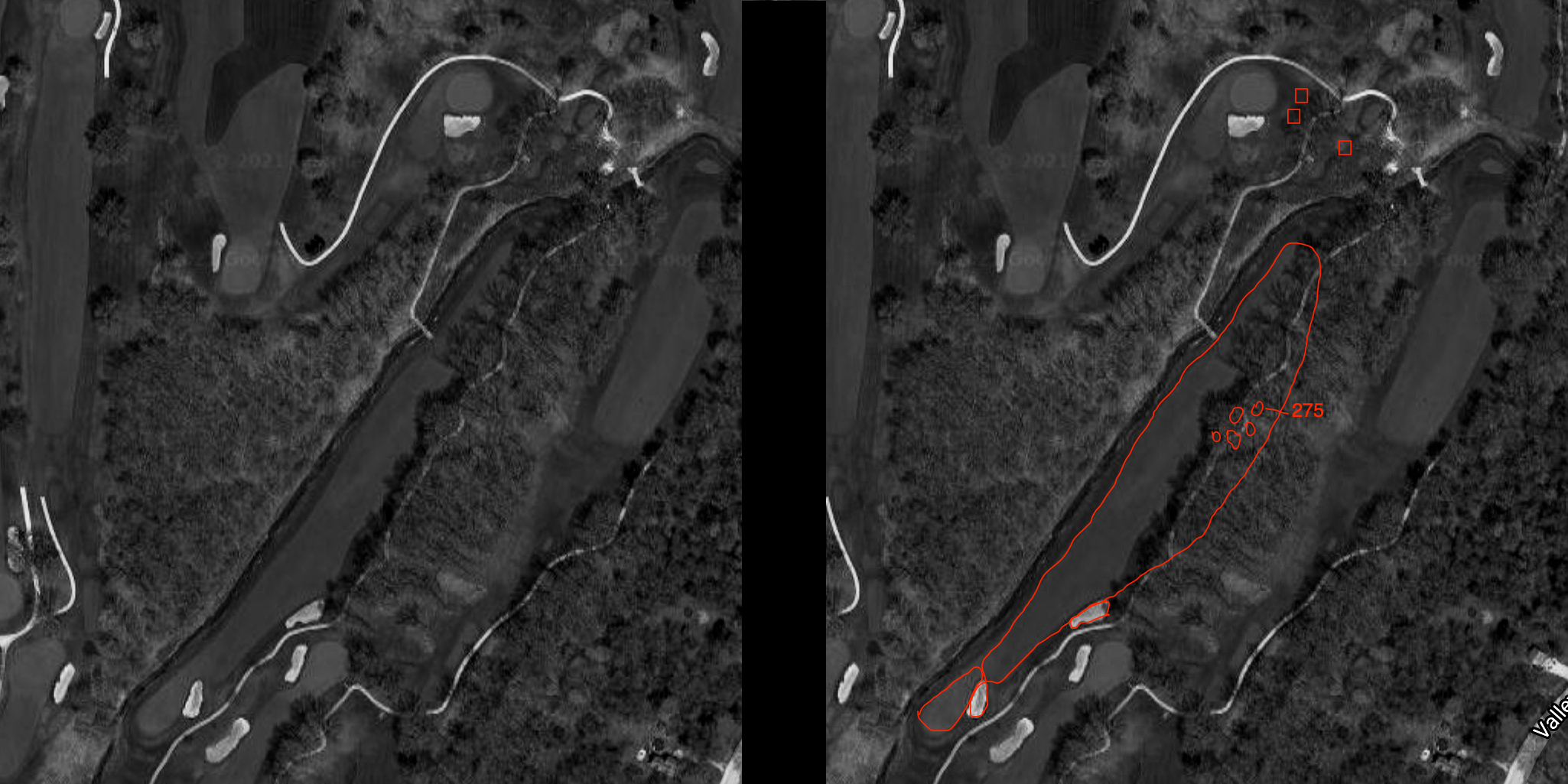 Probably took out more trees than we needed to, but that’s a hip thing to do on GCA social media. (Photo Cred: BPBM Graphics Team)
Probably took out more trees than we needed to, but that’s a hip thing to do on GCA social media. (Photo Cred: BPBM Graphics Team)
What would happen if MIKE HURDZAN AND DANA FRY renovated NO. 17 at THE GOLF CLUB?
So which Dye did I play during 2021? The Golf Club. So yes, I did actually play what most people consider a Top 100-in-the-world course. Technically, I played two, but I’m not including Bethpage Black because I don’t buy its legitimacy on that list. I digress.
The Golf Club is an interesting property full of interesting ideas, some of which I’m not a fan of. The closing hole and its forced carry to a huge green, for example. That par four, however, fits the theme of conceptual intrigue that runs throughout the course. Dye was airing his mindset out to the world, and it’s curious to me why so many describe its pleasures as “subtle” when in fact every hole is incredibly differentiated.
And that’s why No. 17 is my least favorite. The Golf Club features three great par fives and, perhaps because this one follows those, it feels more like a mishmash of the previous three. A few big bunkers, some water on the left. Most off-putting to me is the opening stretch…nearly 430 yards before arriving at the first bunker. If this were more compelling land, with roll like Davenport’s, sure!
 You’ve reached the first bunker, following a 430-yard hike. (Photo Cred: BPBM)
You’ve reached the first bunker, following a 430-yard hike. (Photo Cred: BPBM)
I’ve seen a range of styles from Michael Hurdzan and Dana Fry’s time together, so this simultaneously gave me free rein and a lack of definitive direction. But I’ve played enough of their “championship” collaborations to know one thing about their par five designs: Centerline bunkers are the thing.
This hole plays nearly 560 yards from the back tees, so few tigers are getting here in two. But if they thought about it, they would need to come from the right. Hurdzan doesn’t tend toward true cross bunkers, however the vertical centerline at Erin Hills No. 14 could serve us well here, placed so that those going long and right will have less fairway to work with.
For most, the second shot will travel toward the second fairway bunker, providing the best angle into the green. Rather than Dye’s large, single bunker, I might take influence from No. 15 at Devil’s Paintbrush, by laying a number of pot bunkers in the landing area for this shot; you can try your luck and land among them but again, the best bet is either to lay up a little shorter for a longer approach, or try to carry the cluster for the shorter shot.
Finally, and I can’t quite say this is necessarily Hurdzan-esque, I’m thinking about eliminating the first fairway bunker on the left. Those who land in this area have a shorter approach, but hardly a better angle. More relevant to me is how little the water comes into play until the green. Let’s get some more shortgrass in there and maybe just a few small centerlines. Fans of the original may find this overkill, but we’re creating a scenario where the various bunkers along this hole guide conservative players on a longer “S” route to the hole.
The more daring players will strive to break out of those guidelines.
 It’s unlike Pete Dye to not get closer to that lake, that’s all we’re saying. (Photo Cred: BPBM Graphics Team)
It’s unlike Pete Dye to not get closer to that lake, that’s all we’re saying. (Photo Cred: BPBM Graphics Team)
What would happen if C.H. ALISON renovated NO. 11 at MORAINE COUNTRY CLUB?
Moraine Country Club may be underrated despite being as well-advertised across GCA social media as it is. I suggest this because we always hear about how great the land is, which is largely true, but we don’t hear as much about how well Alex “Nipper” Campbell coupled strategic design elements to the great piece of land he was gifted. He’s not as popular a name to drop in conversation as “Ross” or “Tillinghast” or even “Alison” (but we’ll come back to that last one).
You may have caught my curious verbiage earlier: The terrain at Moraine is “largely” great. And that’s because there’s the one corner near the clubhouse that no one shoots photos of. It’s not the gorgeous, bubbling topography the club takes its name from. It’s relatively flat, without natural hiccups to complicate lies or angles. Campbell did his best, adding a few interesting touches for challenge along with strategically-placed bunkers.
 This is an example of the great terrain at Moraine. This is not No. 11. (Photo Cred: BPBM)
This is an example of the great terrain at Moraine. This is not No. 11. (Photo Cred: BPBM)
But we need a famous architect to make it better for the sake of this exercise, and so Alison will aim to better No. 11, the meat on this flat, three-hole sandwich, which ended up with the least interesting terrain as a result.
The Brit (Alison) was known for raising his putting surfaces and the Scot (Campbell) elevated No. 10’s green so that a poor approach could roll off to the left, back, or front (or just spin back to the front). No. 11 almost looks like it was intended to do the same, however the turf on the slope is maintained as rough, rather than as shortgrass. Alison, more brutish by nature, will opt to trim it down.
Sure, back-to-back holes with the same short-game complications wouldn’t be my ideal approach. But to improve No. 11, I (and Alison) am willing.
Although the average bunker at Moraine is not tremendously large, Alison was notorious for preferring big, deep bunkers (to the point that the style is referred to as an “Alison” in Japan). There’s currently only one fairway bunker, relatively shallow, which we reckon the new architect would find distasteful. Unfortunately, the water table is probably relatively low (due to the creek the flows ahead of the tee) so Alison will settle for adding two more bunkers in a stoplight arrangement: The existing hazard will be in the center, with a longer bunker of the same depth nearer to the tee. A slightly shorter, and slightly deeper trap will sit closer to the green.
Relatively minor tweaks but enough to please the challenge-happy Alison. And me, I guess.
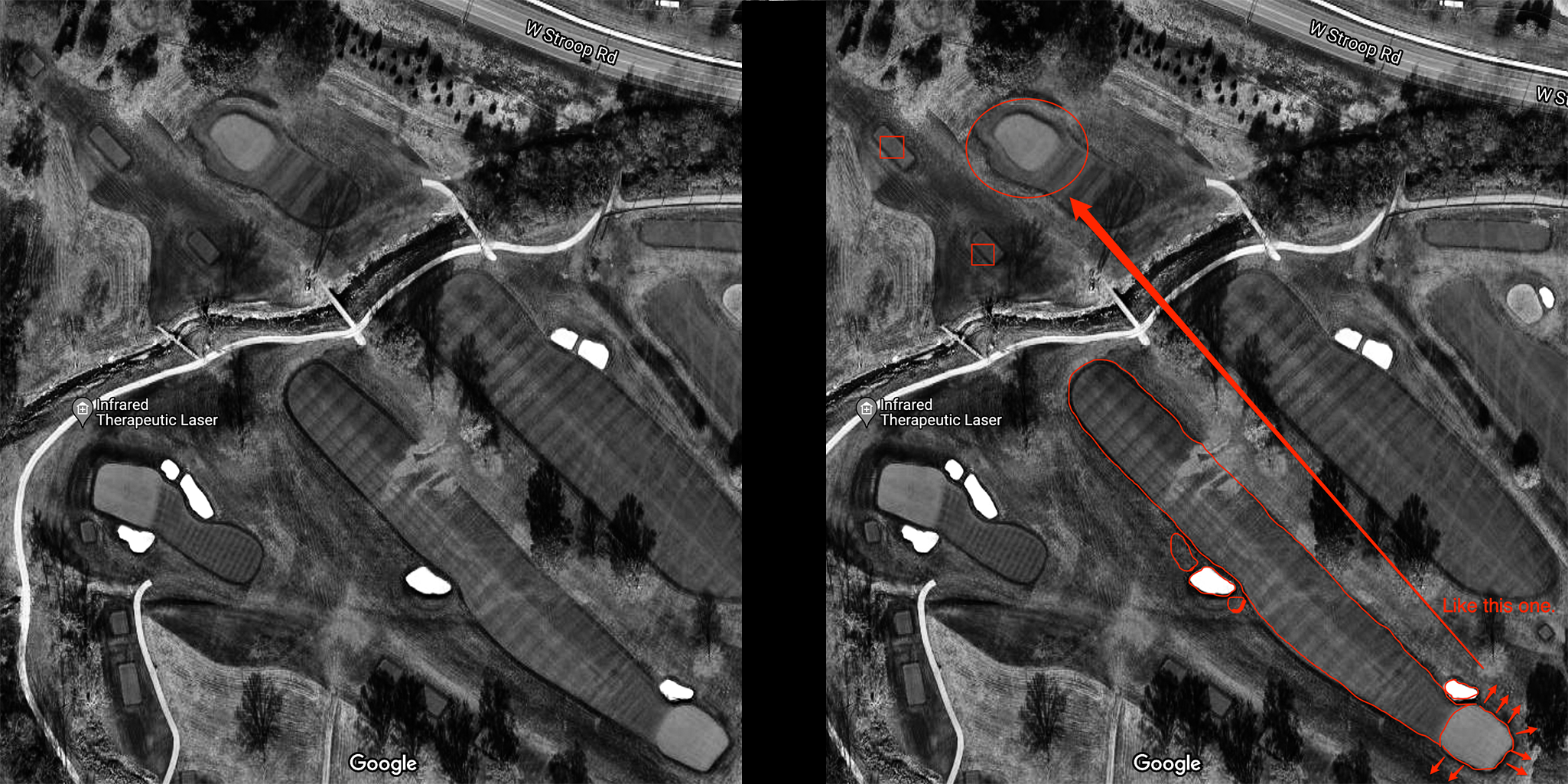 I’d also like to make this a dogleg-right but the skinny nature of the Moraine property limit me. It’s one of the prime reasons why Moraine has roughly half a dogleg in its roster. (Photo Cred: BPBM Graphics Team)
I’d also like to make this a dogleg-right but the skinny nature of the Moraine property limit me. It’s one of the prime reasons why Moraine has roughly half a dogleg in its roster. (Photo Cred: BPBM Graphics Team)
What would happen if A.W. TILLINGHAST renovated NO. 16 at RHODE ISLAND COUNTRY CLUB?
“Ah thank God,” says the world’s most basic GCA enthusiast as he reads. “I was worried this entire post was going to be modern architects and/or relative Golden Age obscurities who did better in Japan or Dayton than anywhere near where I live.”
Well you got your wish. Here’s Tillie taking his more aggressive personality to Donald Ross’s Rhode Island Country Club.
One argument I fall in the minority opinion for: Should a course’s natural setting be considered when analyzing the quality of a course or hole? For example, is Pebble Beach actually better than Pinehurst No. 2, or is it just the ocean hypnotizing you? I don’t know the answer for this specific hypothetical, but I know I can also defend the quality of the aforementioned Kiawah Ocean course without otherwise using the word “ocean.” So my answer is a soft “no.”
The inland portion of Rhode Island Country Club, the first 14 holes, are excellent. You come up to the No. 14 green and see Narragansett Bay for the first time during the round…great routing decision. And then you cross the street and trip on a tree root and splay out everywhere. This is an exaggeration, but the opening two-hole stretch on the prettiest piece of the property bothered me.
A series of four large bunkers serve as a barrier to the shared fairway between parallel nos. 15 and 16. There’s no reason to challenge them during 15; the tee shot that hugs Nayatt Road offers the best line in to a well-guarded green, a la the original “Road” hazard. Players again avoid the bunkers on No. 16, playing along a thin drainage ditch for the best angle. It strikes me, and Tillie, that Ross’s bunkering deserves to be more than just eye-catching. But we can also make it more eye-catching because Tillie.
 That stuff in the waste area is supposed to be scrub grass. Not arrows suggesting the bunker angles aggressively toward the fairway. I probably should have inset the “pews” a bit more as well. (Photo Cred: BPBM Graphics Team)
That stuff in the waste area is supposed to be scrub grass. Not arrows suggesting the bunker angles aggressively toward the fairway. I probably should have inset the “pews” a bit more as well. (Photo Cred: BPBM Graphics Team)
Aesthetics first. Let’s convert the four bunkers into a not-quite-Great Hazard, which widens as it travels away from the tee, making the longer shot more risky than the shorter one. This might stick out like a sore thumb at many Ross courses, but not at RICC: No. 8 features a Great Hazard-esque cross hazard at No. 8, and there are records indicating that a huge waste area once surrounded the No. 17 par three (perhaps the club will restore that as well as they conduct the work we propose).
As you may have noted based on my earlier complaints, reshaping this bunker doesn’t make it strategic. To do so, we’ll need to flip Ross’s existing green so that it’s more open to shots from the left, rather than the right. The approach into this green must be accurate, as a series of four bunkers escort players to the putting surface. We’ll swap sides for these as well, to emphasize position off the tee (as Ross had also done). To add a taste of Tillie, however, I’m going to convert the largest of these (now front and right) into a series of three pews, a la No. 4 at the Philadelphia Cricket Club.
Are you, as a Ross fan, offended by the Tillie take? Don’t worry…here comes revenge.
What would happen if DONALD ROSS renovated NO. 17 at SANDS POINT GOLF CLUB?
You may have guessed from my brand, but I’m a Tillinghast fan. That said, I’m not so arrogant as to think Donald Ross couldn’t contribute a little something-something here and there. And so we arrive at Sands Point Golf Club, the better of the two Tillies I played during my Long Island trip late this year (see Bethpage Black screed above).
Sands Point is a consistent golf course, and an underrated one. What it lacks in showstoppers — like a true Great Hazard hole — it makes up for with an equal lack of filler holes. The par threes impressed me during the round but, in retrospect, I’ve realized No. 17 lacked a personality to set it apart among its cohorts. For example, no. 7 already offers a (better) take on head-on approaches to a par three putting surface.
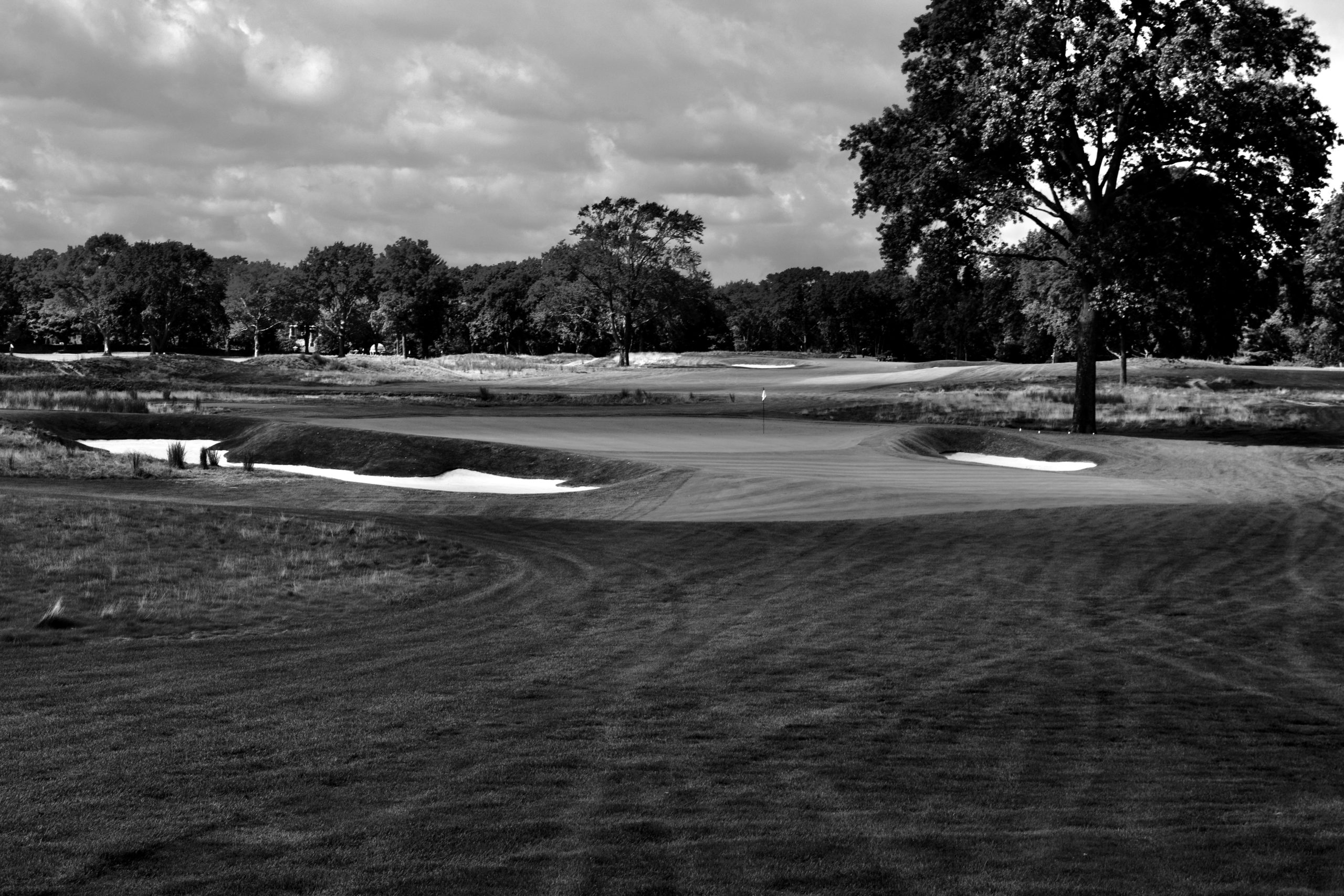 This isn’t even No. 7. It’s No. 12, which is my actual favorite par three on the property. (Photo Cred: BPBM)
This isn’t even No. 7. It’s No. 12, which is my actual favorite par three on the property. (Photo Cred: BPBM)
An obvious “Ross” move would be to move the tee box up, surround the plateaued green with hazards and create a “Volcano” template. This would be cut from the same cloth, however, as No. 2, an 130-yard Tillinghast “Tiny Tim.” There’s no real room on the edge of the property to lengthen the hole, so perhaps the best way to differentiate in terms of distance is to shorten it by 10 yards, to about 150, which can be done by sliding the tee box just a few yards to its left (sorry guys…you’ll need to re-route the cart path).
The move to the left is convenient as, fortunately for us, Tillie’s green slopes gently from right to left. Moving the tee box forces players to work the ball from right to left and use the slope to get down to pins in the front or back…hey, sounds like a Redan! Ross, like many Golden Age architects (including Tillinghast), was happy to include this template in his designs.
Granted, this is shorter than your average Redan. That won’t stop Ross; consider his 160-yarder at Cedar Rapids Country Club. As with that hole, he can remove the now-backing bunker from Tillinghast’s iteration and create a shortgrass collection area down the back (which may be an even more difficult recovery than the larger bunker out front).
 To be fair, I think the go-to response when answering “how to improve this hole” for any armchair architecture snob is to say “make it a redan.” (Photo Cred: BPBM Graphics Team)
To be fair, I think the go-to response when answering “how to improve this hole” for any armchair architecture snob is to say “make it a redan.” (Photo Cred: BPBM Graphics Team)
What would happen if ALEX “NIPPER” CAMPBELL renovated NO. 15 at SHELTER HARBOR GOLF CLUB?
There are 14 par threes on the Shelter Harbor Golf Club property — five during its championship route and a nine-hole par three course. I had a chance to discuss the idea of par-three overload with Dana Fry, and whether adding short courses create concerns among architects that they’ll run out of good ideas for par threes. The short summary of our chat: He said “no.”
That said, I was curious about No. 15. On a course chock full of bold architectural moves, it seemed…plain?
For comparison, the course also includes a notorious Biarritz interpretation (No. 4), a subtly-uphill angler with five deep bunkers guarding the front (No. 11), and even the Floridian pond-hugger was better than most you’ll find in the panhandle (even if it’s a little out of character, at No. 17). No. 15 is long, straight and a few bunkers left that don’t exactly impose. The green itself is not bad; a putting surface with two tiers always has the potential to impress. The issue is whether collaborating hazards call for execution, and even thought, from the player.
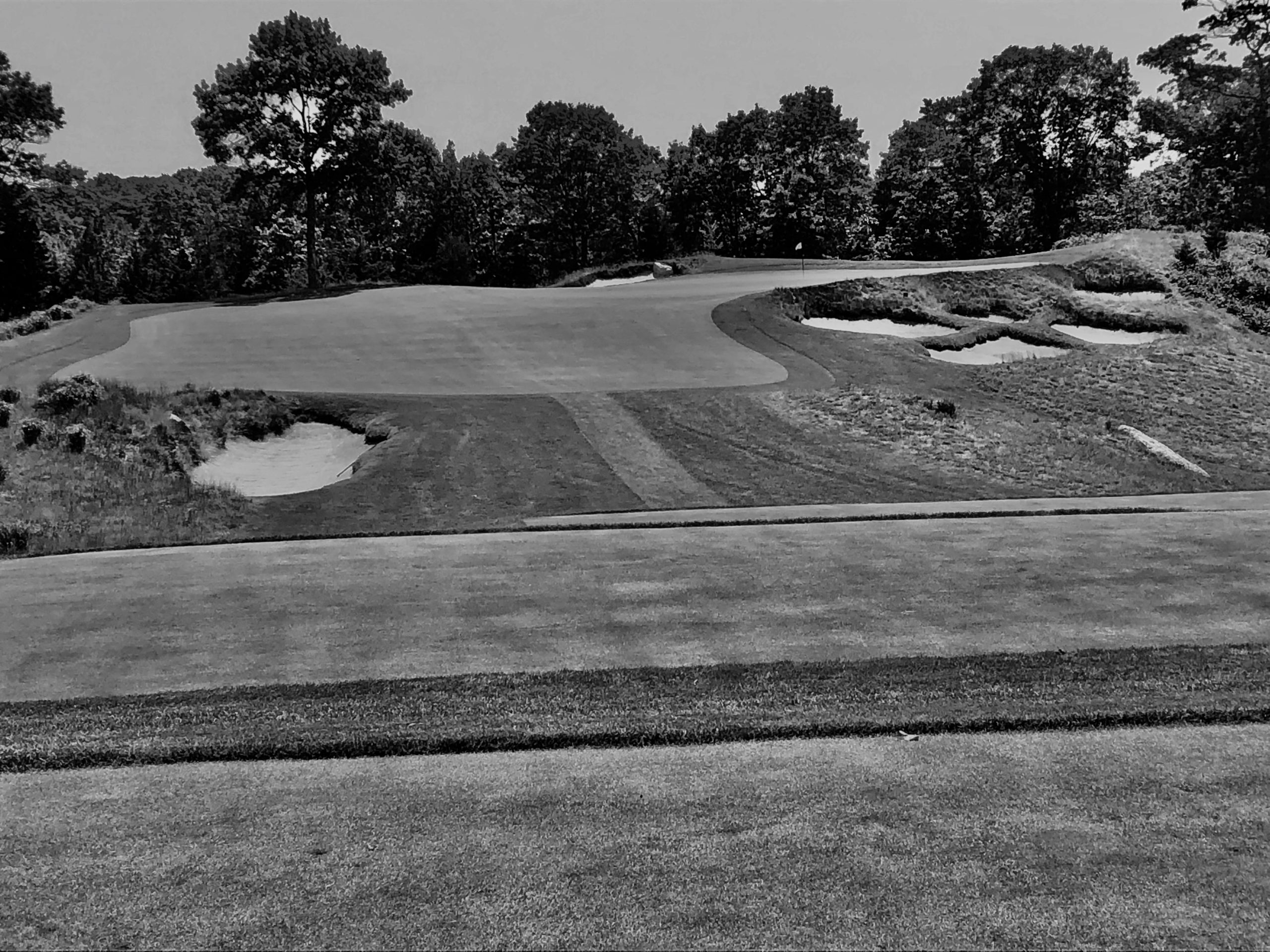 Was really leaning on Robbie Vogel to lend me a photo of No. 15 but he didn’t come through, so you get No. 11 instead. (Photo Cred: Well, it definitely wasn’t Robbie Vogel)
Was really leaning on Robbie Vogel to lend me a photo of No. 15 but he didn’t come through, so you get No. 11 instead. (Photo Cred: Well, it definitely wasn’t Robbie Vogel)
Fortunately, Campbell had created a model at Moraine from which he could modulate No. 15 at Shelter Harbor.
As I beat up on the corner of Moraine that houses nos. 10-12, I didn’t do enough to highlight just how good No. 12 is, regardless of location. A “short” hole in name only, playing 245 yards from the back tees, this is a reasonable par 3.5 for most. As with the other two holes on this flat stretch, Campbell places the green atop a raised platform. Bunkers short and right require a carry, prior to running up the right side of the green, which will then feed to the left (a bunker front-left makes it difficult to directly attack flags on the left). Come in too hot and your ball can roll off left, right, and back (or end up in the bunker left).
We can recreate these bunkers almost to a tee at Shelter Harbor’s No. 15, which also tends to feed right-to-left. If there’s a flag in the back (242 yards from the back tee), players will need to carry the front-right bunkers before running it up. It’s the exact same shot they would make today, but the bunker adds doubt to the equation…doubt that doesn’t exist right now.
Attacking a long pin on this thin, 44-yard-deep green is always the scarier shot today. Adding Campbell’s prescribed bunkers makes the front of this green just as scary, however. Once again, it’s the same shot as real life, but with intimidating bunkers. These traps may encourage players to go long, and — like most at Shelter Harbor — you would much rather be below the hole. My money’s not on making a two-putt coming the opposite way. And, considering Campbell’s notoriety for greens, he’s probably shaping a few more weird breaks into this one as well.
 Hurdzan and Fry are still respectively based out of Columbus, I think, so I’m keeping a nervous eye out my office window. (Photo Cred: BPBM Graphics Team)
Hurdzan and Fry are still respectively based out of Columbus, I think, so I’m keeping a nervous eye out my office window. (Photo Cred: BPBM Graphics Team)